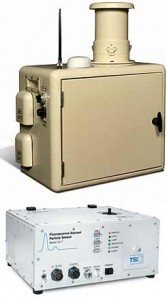C-FLAPS is the latest biological detection system from a distinguished pedigree of proven, fielded and flexible solutions by the team of Dycor Technologies Ltd. and TSI Incorporated. It is an off-the-shelf system, deployed operationally with defense (reconnaissance vehicles, fixed-site), homeland security, public health and advanced research customers around the world today.
The Fluorescence Aerosol Particle Sensor (FLAPS 3317 – manufactured by TSI Inc.), which in combination with Dycor’s XMX High Volume Aerosol Particle Concentrator, is the primary biological triggering device in the C-FLAPS biological detection system.

The technology is based on fluorescence detection of enzymes present only in live organisms and the biological detection system comes complete with CBNET alarm algorithms and control software. C-FLAPS is the most sensitive biological detector available on the market today, with a focus on minimizing false positives and false negatives through the advanced alarming algorithms that are provided with each system.
C-FLAPS operates on the following principles:
- Concentration of the particle stream for delivery into a biological trigger in volumes and concentrations that provide for rapid positive detection is achieved by the XMX/2A air-to-air concentrator. The XMX/2A provides a variable airflow of up to 350 SLPM that can be fine tuned to respond to specific environmental conditions as required. The most important function the concentrator performs is to improve the signal-to-noise ratio.
- Discrimination and elimination of particles outside the important respirable range of 1-10 μm. Aerosol science demonstrates a high degree of improbability of submicron pathogens traveling as single entities, rather forming agglomerations which fall within the respirable range. Respirable aerosols under 1 micron are re-expelled by the lungs, particles larger than 10 microns either drop out of aerosol due to gravity or lodge in upper respiratory tract for less-than-ideal pathogenicity. The unique design of the XMX/2A aerosol concentrator makes it a particle separator, restricting particle intake to those within this range of interest.
- Fluorescence excitation of NADH and Riboflavin, (compounds which are present only in live organisms), and measurement of their fluorescence emissions along two wavelengths, along with scattered light intensity readings, providing exceptional discrimination and rejection of interferents. This function is provided by the FLAPS III 3317-40 Biological Trigger. This instrument is derived from the highly successful and fielded FLAPS II -based detection systems thatestablished this technology as the recognized benchmark for the industry, both in test ranges and now in fielded solutions.
- Using integrated alarming algorithms, giving the operator the ability to vary parameters based on background conditions in order to minimize false alarms, so as to differentiate between non-living and harmless interferents, and actual biological events. Multiple algorithm methodologies are employed to maintain the high sensitivity while minimizing false alarms. Continuous refinement of those algorithms through numerous chamber trials, field trials, and deployed background studies is key to the minimization of false alarms.
- Wet and/or dry collection of samples upon verification of a biological event, in media that allow for rapid onsite PCR identification as well as laboratory culturing. C-FLAPS can be configured to connect to Dycor’s XMX/2L-MIL High-Volume Aerosol Collector, to automatically initiate sample collection (liquid or dry impingement) upon detection of a biological event.
- Communications and interface with Command and Control functions are achieved through the Ethernet port, or optionally, by an embedded Spread Spectrum Data Radio operating within our clients’ national communications frequency restrictions (North America regions).
- An embedded global positioning system provides GPS location and time-stamping capability.
- All disciplines are integrated into one seamless system.
- Ruggedized laser technology allows for operational field deployment.
